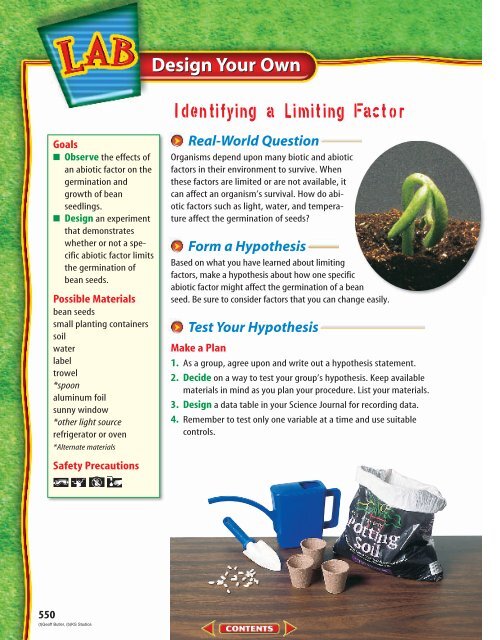Chapter 18: Interactions of Living Things
Chapter 18: Interactions of Living Things
Chapter 18: Interactions of Living Things
You also want an ePaper? Increase the reach of your titles
YUMPU automatically turns print PDFs into web optimized ePapers that Google loves.
550<br />
Goals<br />
■ Observe the effects <strong>of</strong><br />
an abiotic factor on the<br />
germination and<br />
growth <strong>of</strong> bean<br />
seedlings.<br />
■ Design an experiment<br />
that demonstrates<br />
whether or not a specific<br />
abiotic factor limits<br />
the germination <strong>of</strong><br />
bean seeds.<br />
Possible Materials<br />
bean seeds<br />
small planting containers<br />
soil<br />
water<br />
label<br />
trowel<br />
*spoon<br />
aluminum foil<br />
sunny window<br />
*other light source<br />
refrigerator or oven<br />
*Alternate materials<br />
Safety Precautions<br />
(t)Ge<strong>of</strong>f Butler, (b)KS Studios<br />
Design Your Own<br />
Identifying a Limiting Factor<br />
Real-World Question<br />
Organisms depend upon many biotic and abiotic<br />
factors in their environment to survive. When<br />
these factors are limited or are not available, it<br />
can affect an organism’s survival. How do abiotic<br />
factors such as light, water, and temperature<br />
affect the germination <strong>of</strong> seeds?<br />
Form a Hypothesis<br />
Based on what you have learned about limiting<br />
factors, make a hypothesis about how one specific<br />
abiotic factor might affect the germination <strong>of</strong> a bean<br />
seed. Be sure to consider factors that you can change easily.<br />
Test Your Hypothesis<br />
Make a Plan<br />
1. As a group, agree upon and write out a hypothesis statement.<br />
2. Decide on a way to test your group’s hypothesis. Keep available<br />
materials in mind as you plan your procedure. List your materials.<br />
3. Design a data table in your Science Journal for recording data.<br />
4. Remember to test only one variable at a time and use suitable<br />
controls.

















